bio.wikisort.org - Plant
A culinary nut is a dry, edible fruit or seed that usually, but not always, has a high fat content. Nuts are used in a wide variety of edible roles, including in baking, as snacks (either roasted or raw), and as flavoring. In addition to botanical nuts, fruits and seeds that have a similar appearance and culinary role are considered to be culinary nuts.[1] Culinary nuts are divided into fruits or seeds in one of four categories:
- True, or botanical nuts: dry, hard-shelled, uncompartmented fruit that do not split on maturity to release seeds; (e.g. hazelnuts) [2][3]
- Drupes: seed contained within a pit (stone or pyrena) that itself is surrounded by a fleshy fruit (e.g. almonds, walnuts);[4]
- Gymnosperm seeds: naked seeds, with no enclosure (e.g. pine nuts);
- Angiosperm: seeds surrounded by an enclosure, such as a pod or a fruit (e.g. peanuts).
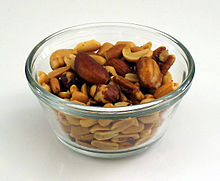
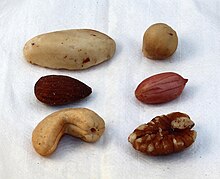
Nuts have a rich history as food. For many indigenous peoples of the Americas, a wide variety of nuts, including acorns, American beech, and others, served as a major source of starch and fat over thousands of years.[5] Similarly, a wide variety of nuts have served as food for Indigenous Australians for many centuries.[6] Other culinary nuts, though known from ancient times, have seen dramatic increases in use in modern times. The most striking such example is the peanut. Its usage was popularized by the work of George Washington Carver, who discovered and popularized many applications of the peanut after employing peanut plants for soil amelioration in fields used to grow cotton.[7]
True nuts

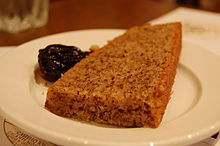

The following are both culinary and botanical nuts.
- Acorn (Quercus, Lithocarpus and Cyclobalanopsis spp.), used from ancient times among indigenous peoples of the Americas as a staple food, in particular for making bread and porridge.[8]
- Beech (Fagus spp.)
- American beech (Fagus grandifolia), used by indigenous peoples of the Americas as food. Several tribes sought stores of beech nuts gathered by chipmunks and deer mice, thus obtaining nuts that were already sorted and shelled.[9]
- European beech (Fagus sylvatica), although edible, have never been popular as a source of food. They have been used as animal feed and to extract a popular edible oil.[10]
- Breadnut (Brosimum alicastrum), used by the ancient Maya peoples as animal fodder, and as an alternative food when yield of other crops was insufficient.[11]
- Candlenut (Aleurites moluccana), used in many South East Asian cuisines.[12]
- Chestnuts (Castanea spp.)
- Guinea peanut (Pachira glabra), like those of the related Malabar chestnut, the seeds taste similar to peanuts[15] and are typically boiled or roasted,[16] with the roasted seeds sometimes ground to make a hot drink.[15]
- Hazelnuts (Corylus spp.), most commercial varieties of which descend from the European hazelnut (Corylus avellana).[17] Hazelnuts are used to make pralines, in the popular Nutella spread, in liqueurs, and in many other foods.
- American hazelnut (Corylus americana), appealing for breeding because of its relative hardiness.[17]
- Deeknut (Corylus dikana), grows in hot, excessively dry areas.[18] An occasional garnish used in Middle Eastern dishes.
- Eastern and western beaked hazel (Corylus cornuta), native to the United States.[19]
- European hazelnut (Corylus avellana), source of most commercial hazelnuts.[19]
- Filbert (Corylus maxima), commonly used as "filler" in mixed nut combinations.[19]
- Several other species are edible, but not commercially cultivated to any significant extent. These include the cold-tolerant Siberian hazelnut (C. heterophylla), C. kweichowensis, which grows in the warmer parts of China, C. sieboldiana, which grows in Japan and China, and other minor Corylus species.[17]
- Johnstone River almond (Elaeocarpus bancroftii), prized food among northern Indigenous Australians.[20]
- Karuka (Pandanus spp.), native to Papua New Guinea. Both the planted and wild species are eaten raw, roasted or boiled, providing food security when other foods are less available.[21]
- Planted karuka (Pandanus julianettii), cultivated species, planted by roughly half the rural population of Papua New Guinea.[22]
- Wild karuka (Pandanus brosimos), important food source in villages at higher altitudes in New Guinea.[22]
- Kola nut (Cola spp.), from a West African relative of the cocoa tree, is the origin of the cola flavor in soft drinks.[23]
- Kurrajong (Brachychiton spp.), native to Australia, highly regarded as a bush food among northern Indigenous Australians.[24]
- Malabar chestnut (Pachira aquatica), have a taste reminiscent of peanuts when raw, and of cashews or European chestnuts (which they strongly resemble) when roasted.[25]
- Mongongo (Ricinodendron rautanenii), abundant source of protein among Bushmen in the Kalahari desert.[26] Also of interest as a source of oil for skin care.[27]
- Palm nuts (Elaeis guineensis), important famine food among the Himba people in Africa.[28]
- Red bopple nut (Hicksbeachia pinnatifolia), native to the east coast of Australia.[29] Low in fat, high in calcium and potassium. Eaten as bush food. Considered similar, but inferior to the macadamia.
- Yellow walnut (Beilschmiedia bancroftii), native to Australia where it served as a staple food among Indigenous Australians.[30]
Drupe seeds
A drupe is a fleshy fruit surrounding a stone, or pit, containing a seed. Some of these seeds are culinary nuts as well.
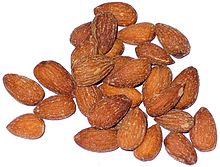
- Almonds (Prunus dulcis) have a long and important history of religious, social and cultural significance as a food.[31] Speculated to have originated as a natural hybrid in Central Asia, almonds spread throughout the Middle East in ancient times and thence to Eurasia. The almond is one of only two nuts mentioned in the Bible.[32]
- Apricot kernels are sometimes used as an almond substitute, an Apricot seed derived ersatz-Marzipan is known as "Persipan" in German and is extensively used in foods like Stollen.
- Australian cashew nut (Semecarpus australiensis) is a source of food for Indigenous Australians of north-eastern Queensland and Australia's Northern Territory.[33]
- Baru nut (Dipteryx alata) is a source of food for indigenous Afro-Brazilian communities living in the Brazilian Cerrado. The nut is eaten toasted or boiled.
- Betel or areca nuts (Areca catechu) are chewed in many cultures as a psychoactive drug.[34] They are also used in Indian cuisine to make sweet after-dinner treats (mukwas) and breath-fresheners (paan masala).[35]
- Borneo tallow nuts (Shorea spp.) are grown in the tropical rain forests of South East Asia, as a source of edible oil.[36]
- Canarium spp.
- Canarium nut (Canarium harveyi, Canarium indicum, or Canarium commune) has long been an important food source in Melanesia.[37]
- Chinese olive (Canarium album) pits are processed before use as an ingredient in Chinese cooking.[38]
- Pili nuts (Canarium ovatum) are native to the Philippines, where they have been cultivated for food from ancient times.[39]
- Cashews (Anacardium occidentale) grow as a drupe that is attached to the cashew apple, the fruit of the cashew tree.[40] Native to northeastern Brazil, the cashew was introduced to India and East Africa in the sixteenth century, where they remain a major commercial crop. The nut must be roasted (or steamed) to remove the caustic shell oil before being consumed.[41]
- Chilean hazel (Gevuina avellana), from an evergreen native to South America, similar in appearance and taste to the hazelnut.[42]
- Coconut (Cocos nucifera), used worldwide as a food. The fleshy part of the seed is edible, and used either desiccated or fresh as an ingredient in many foods. The pressed oil from the coconut is used in cooking as well.[43]
- Gabon nut (Coula edulis) has a taste comparable to hazelnut or chestnut. It is eaten raw, grilled or boiled.[44]
- Hickory (Carya spp.)
- Mockernut hickory (Carya tomentosa), named after the heavy hammer (moker in Dutch) required to crack the heavy shell and remove the tasty nutmeat.[45]
- Pecans (Carya illinoinensis) are the only major commercial nut tree native to North America.[46] Pecans are eaten as a snack food, and used as an ingredient in baking and other food preparation.
- Shagbark hickory (Carya ovata) has over 130 named cultivars. They are a valuable source of food for wildlife, and were eaten by indigenous peoples of the Americas and settlers alike.[47]
- Shellbark hickory (Carya laciniosa) nuts are sweet, and are the largest of the hickories. They are also eaten by a wide variety of wildlife.[48]
- Irvingia spp. are native to Africa
- Jack nuts (Artocarpus heterophyllus) are the seeds of the jack fruit. With a taste like chestnuts, they have an extremely low fat content of less than 1%.[50]
- Jelly Palm Nut (Butia capitata), sweet edible fruit, and edible nut.
- Bread Nuts (Artocarpus camansi) similarly have a chesnut taste and very low fat content
- Panda oleosa is used in Gabon in a similar way to bush mango nuts, as well as to extract an edible oil.[51]
- Pekea nut, or butter-nut of Guiana (Caryocar nuciferum), harvested locally for its highly prized edible oil.[36]
- Pistachio (Pistacia vera L.), cultivated for thousands of years, native to West Asia.[52] It is one of only two nuts mentioned in the Bible.[32]
- Walnut (Juglans spp.)
- Black walnut (Juglans nigra), also popular as food for wildlife, with an appealing, distinctive flavor. Native of North America.[53]
- Butternut (Juglans cinerea) (or white walnut) is native to North America. Used extensively, in the past, by Native American tribes as food.[54]
- English walnut (Juglans regia) (or Persian walnut) was introduced to California around 1770. California now represents 99% of US walnut growth.[55] It is often combined with salads, vegetables, fruits or desserts because of its distinctive taste.
- Heartnut, or Japanese walnut (Juglans aitlanthifolia), native to Japan, with a characteristic cordate shape.[56] Heartnuts are often toasted or baked, and can be used as a substitute for English walnuts.
Nut-like gymnosperm seeds

A gymnosperm, from the Greek gymnospermos (γυμνόσπερμος), meaning "naked seed", is a seed that does not have an enclosure. The following gymnosperms are culinary nuts. All but the ginkgo nut are from evergreens.
- Cycads (Macrozamia spp.)[57]
- Ginkgo nuts (Ginkgo biloba) are a common ingredient in Chinese cooking. They are starchy, low in fat, protein and calories, but high in vitamin C.[59]
- Araucaria spp.
- Bunya nut (Araucaria bidwillii) is native to Queensland, Australia. Nuts are the size of walnuts, and rich in starch.[60]
- Monkey-puzzle nut (Araucaria araucana) has nuts twice the size of almonds. Rich in starch. Roasted, boiled, eaten raw, or fermented in Chile and Argentina.[60]
- Paraná pine nut (Araucaria angustifolia) (or Brazil pine nut) is an edible seed similar to pine nuts.[61]
- Pine nuts (Pinus spp.) Pine nuts can be toasted and added to salads and are used as an ingredient in pesto, among other regional uses.
- Chilgoza pine (Pinus gerardiana), common in Central Asia. Nuts are used raw, roasted or in confectionery products.[62]
- Colorado pinyon (Pinus edulis), in great demand as an edible nut, with average annual production of 454 to 900 tonnes.[63]
- Korean pine (Pinus koraiensis), a pine-nut yielding species native to Asia.[64]
- Mexican pinyon (Pinus cembroides), found in Mexico and Arizona. Nuts are eaten raw, roasted, or made into flour.[65]
- Single-leaf pinyon (Pinus monophylla) grows in foothills from Mexico to Idaho. Eaten as other pine nuts. Also sometimes ground and made into pancakes.[66]
- Stone pine, or pignolia nut (Pinus pinea) is the most commercially important pine nut.[64]
Nut-like angiosperm seeds
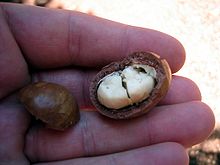
These culinary nuts are seeds contained within a larger fruit, and are flowering plants.
- Brazil nuts (Bertholletia excelsa) are harvested from an estimated 250,000–400,000 trees per year. Highly valued edible nut used in the confectionery and baking trades.[36] Excellent dietary source of selenium.[67]
- Macadamia (Macadamia spp.) are primarily produced in Hawaii and Australia. Both species are native to Australia. They are a highly valued edible nut. Waste nuts are commonly used to extract an edible oil.[36]
- Macadamia nut (Macadamia tetraphylla) has a rough shell, and is the subject of some commercialization.[68]
- Queensland macadamia nut (Macadamia integrifolia) has a smooth shell, and is the principal commercial macadamia nut.[68]
- Paradise nut (Lecythis usitata), native to the Amazon rain forest, highly regarded by indigenous tribal people.[69]
- Peanut, or groundnut (Arachis hypogaea), originally from South America, has grown from a relatively minor crop to one of the most important commercial nut crops, in part due to the work of George Washington Carver at the beginning of the 20th century.[7]
- Peanut tree (Sterculia quadrifida) or bush peanut, native to Australia. Requires no preparation.[70][note 1]
- Soybeans (Glycine max) are used as a nut, in addition to their use as oil seeds.[71]
See also
- List of edible seeds
- Tiger nut (not a nut, despite its name)
Notes
- Not to be confused with peanuts (groundnuts).
References
- Bewley, J. Derek; Black, Michael; Halmer, Peter (2006). The encyclopedia of seeds: science, technology and uses. CABI. p. 444. ISBN 0-85199-723-6. Retrieved 2011-11-21.
- "Nut". The American Heritage® Dictionary of the English Language (Fourth ed.). Houghton Mifflin Company. 2000. Retrieved 2011-11-21.
- "Nuts and derived products". Definition and Classification of Commodities. Food and Agriculture Organization of the United Nations (FAO). 1996. Retrieved 2011-11-21.
- "Drupe". Collins English Dictionary – Complete and Unabridged 11th Edition. Harper-Collins Publishers. 2012. Retrieved 2012-09-05.
- Moerman 2010.
- Clarke, Philip A. (2008). Aboriginal plant collectors: botanists and Australian aboriginal people in the nineteenth century. Rosenberg Pub. ISBN 978-1-877058-68-4. Retrieved 2011-11-21.
- "History of peanuts". National Peanut Board. Archived from the original on 2007-10-23. Retrieved 2011-11-22.
- Moerman 2010, p. 206–212.
- Moerman 2010, p. 114.
- Janick & Paull 2008, p. 405.
- Rosengarten, Jr. 2004, p. 276.
- Laudan, Rachel (1996). The food of Paradise: exploring Hawaii's culinary heritage. University of Hawaii Press. p. 231. ISBN 0-8248-1778-8. Retrieved 2011-11-21.
- Simoons, Frederick J. (1991). Food in China: a cultural and historical inquiry. CRC Press. p. 268. ISBN 0-8493-8804-X. Retrieved 2011-11-21.
- Shakuntala, N.; Manay, O. (2001). Food: Facts And Principles (Second ed.). New Age International. p. 307. ISBN 81-224-1325-0. Retrieved 2011-11-21.
- "Pachira glabra Pasq." at Plant Biodiversity Conservatory and Research Core of University of Connecticut. Retrieved 10 May 2020.
- "Pachira glabra - Pasq." at Plants For A Future. Retrieved 10 May 2020.
- Thompson, Maxime M.; Lagerstedt, Harry B.; Mehlenbacher, Shawn A. (2 May 1996). "Hazelnuts". In Janick, Jules; Moore James N. (eds.). Nuts. Fruit Breeding. Vol. 3. p. 125ff. ISBN 9780471126690. Retrieved 2011-11-21.
- "Common and Exotic Fruit and Nut Trees". www.rawganique.com. Retrieved 2016-01-22.
- Smith, Andrew F. (2007). The Oxford companion to American food and drink. Oxford University Press. p. 219. ISBN 978-0-19-530796-2. Retrieved 2011-11-21.
- Clarke, Philip A. (2008). Aboriginal plant collectors: botanists and Indigenous Australians in the nineteenth century. Rosenberg Pub. p. 34. ISBN 978-1-877058-68-4. Retrieved 2011-11-21.
- Bourke, R. M.; Allen, M. G.; Salisbury, J. G. (31 August 2001). Food security for Papua New Guinea: proceedings of the Papua New Guinea Food and Nutrition 2000 Conference. PNG University of Technology. ISBN 1-86320-308-7. Retrieved 2012-01-16.
- Bourke, R. Michael; Harwood, Tracy (2009). Food and Agriculture in Papua New Guinea. Australian National University. p. 216. ISBN 978-1-921536-60-1. Retrieved 2011-11-22.
- Attokaran, Mathew (2011). Natural Food Flavors and Colorants. John Wiley & Sons. p. 64. ISBN 978-0-8138-2110-8. Retrieved 2011-11-21.
- Dixon, Robert M. W.; Moore, Bruce (2006). Australian Aboriginal words in English: their origin and meaning (Second ed.). Oxford University Press. p. 114. ISBN 0-19-554073-5. Retrieved 2011-11-21.
- Edible: an illustrated guide to the world's food plants. National Geographic Books. 2008. p. 245. ISBN 978-1-4262-0372-5.
- Lee, Robert B. (1979). Hunter-Gatherers in Process: The Kalahari Research Project, 1963-1976 (PDF). Academic Press. p. 319. Retrieved 2011-11-22.
- Bafana, Busani (July 2009). "Mongongo–a tough nut worth cracking". New Agriculturist. Retrieved 2011-04-28.
- Bollig, Michael (2006), "Risk management in a hazardous environment: a comparative study of two pastoral societies", Studies in human ecology and adaptation, Birkhäuser, vol. 2, p. 193, ISBN 0-387-27581-9, retrieved 2011-11-22
- Janick & Paull 2008, p. 600.
- Harris, Marvin; Ross, Eric B. (1989). Food and Evolution: Toward a Theory of Human Food Habits. Temple University Press. p. 364. ISBN 0-87722-668-7. Retrieved 2011-11-22.
- "History of Almonds". Almond Board of California. Archived from the original on 2011-11-26. Retrieved 2011-11-22.
- McNamee, Gregory (2007). Movable feasts: the history, science, and lore of food. Greenwood Publishing Group. p. 2. ISBN 978-0-275-98931-6.
- Janick & Paull 2008, p. 29.
- "Betel chewing". Singapore Infopedia. National Library Singapore. 5 May 1999. Archived from the original on 2008-10-15.
- "Betelnut–food". Plant Cultures. Archived from the original on 2011-09-18. Retrieved 2011-11-22.
- Axtell, B.L. (1992). Minor oil crops. Research by R.M. Fairman. Food and Agriculture Organization of the United Nations (FAO). Retrieved 2011-11-18.
- "Canarium indicum var. indicum and Canarium harveyi (canarium nut)" (PDF), Species Profiles for Pacific Island Agroforestry, p. 2, April 2006, retrieved 2011-11-22
- Newman, Jacqueline M. (2004). Food culture in China. Food culture around the world. Greenwood Publishing Group. p. 47. ISBN 0-313-32581-2. Retrieved 2011-11-22.
- "What is the history of pili nuts?". PiliNuts.org. Archived from the original on 2011-11-06. Retrieved 2011-11-22.
- Bewley, J. Derek; Black, Michael; Halmer, Peter (2006). The encyclopedia of seeds: science, technology and uses. CABI. p. 61. ISBN 0-85199-723-6. Retrieved 2011-11-22.
- Rieger, Mark (2006). Introduction to fruit crops. Psychology Press. p. 135–136. ISBN 1-56022-259-X.
- Rosengarten, Jr. 2004, p. 281-282.
- Santos, GA; Batugal, P.A.; Othman, A.; Baudouin, L.; Labouisse, J.P. (eds.). "Botany of the Coconut Palm". Manual on Standardized Research Techniques in Coconut Breeding. International Plant Genetics Research Institute. Archived from the original on 2012-03-23. Retrieved 2011-11-21.
- "Coula edulis". World Agroforestry Tree Database. Archived from the original on 2012-04-06. Retrieved 2011-11-22.
- Brill, Steve; Dean, Evelyn (1994). Identifying and Harvesting Edible and Medicinal Plants. HarperCollins. p. 171. ISBN 0-688-11425-3. Retrieved 2011-12-04.
- "The History of Pecans, A Pecan Timeline and Fun Facts". National Pecan Shellers' Association. Archived from the original on 2011-10-06. Retrieved 2011-11-22.
- Grauke, L.J. "C. ovata (Mill.) K. Koch. Shagbark hickory". USDA-ARS Pecan Genetics. Retrieved 2011-11-22.
- Neso, Guy. "Shellbark Hickcory–Carya laciniosa (Michx. f.) G. Don" (PDF). USDA. Retrieved 2011-11-22.
- Janick & Paull 2008, p. 420.
- Rosengarten, Jr. 2004, p. 294.
- van der Vossen, H.A.M. & Mkamilo, G.S. (2007), "Vegetable oils", Plant resources of tropical Africa, PROTA, vol. 14, p. 129, ISBN 978-90-5782-191-2
- "History of the pistachio - in a nutshell". Pistachio Growers Association. Archived from the original on 2011-08-27. Retrieved 2011-11-22.
- Angier, Bradford (1974). Field guide to edible wild plants. Stackpole Books. p. 38. ISBN 0-8117-2018-7. Retrieved 2011-11-22.
black walnut.
- Moerman 2010, p. 132.
- Ramos, David E. (1997). Walnut production manual. ANR Publications. p. 8. ISBN 1-879906-27-9. Retrieved 2011-11-22.
- Rosengarten, Jr. 2004, p. 288.
- Hill, Ken D. "Genus Macrozamia". The Cycad Pages. Royal Botanic Gardens Sydney. Retrieved 2011-11-22.
- Robinson, Les. Aboriginal Uses of Plants Around Sydney. SGAP 17th Biennial Seminar. Robert Menzies College, Sydney. Retrieved 2011-11-22.
- Simoons, Frederick J. (1991). Food in China: a cultural and historical inquiry. CRC Press. p. 274. ISBN 0-8493-8804-X. Retrieved 2011-11-22.
- Nugent & Boniface 2004, p. 41.
- Nesbitt, Mark (2005). The Cultural history of plants. Taylor & Francis. p. 140. ISBN 0-415-92746-3. Retrieved 2011-12-03.
- Dewan, M. L.; Nautiyal, M. C.; Sah, V. K.; Trees for Life, India (1992). Nut fruits for the Himalayas. Concept Publishing Company. pp. 114–116. ISBN 81-7022-399-7. Retrieved 2011-11-22.
- C.A.B. International (2002). Pines of silvicultural importance. CABI. p. 113. ISBN 0-85199-539-X. Retrieved 2011-11-22.
- Janick & Paull 2008, p. 595.
- Nugent & Boniface 2004, p. 43.
- Nugent & Boniface 2004, p. 44.
- Alasalvar, Cesarettin; Shahidi, Fereidoon (2008). Tree nuts: composition, phytochemicals, and health effects. CRC Press. p. 148. ISBN 978-0-8493-3735-2. Retrieved 2011-11-22.
- Rieger, Mark (2006). Introduction to fruit crops. Psychology Press. p. 259. ISBN 1-56022-259-X. Retrieved 2011-11-23.
- Rosengarten, Jr. 2004, p. 306.
- Isaacs, Jennifer (1987). Bush food: Aboriginal food and herbal medicine. Weldons. p. 85. ISBN 0-949708-33-X. Retrieved 2011-11-22.
- Rosengarten, Jr. 2004, p. 324.
Works cited
- Janick, Jules; Paull, Robert E. (2008). The Encyclopedia of Fruit and Nuts. CABI. ISBN 978-0-85199-638-7. Retrieved 2022-09-11.
- Moerman, Daniel E. (2010). Native American Food Plants: An Ethnobotanical Dictionary. Timber Press. ISBN 978-1-60469-189-4. Retrieved 2011-11-21.
- Nugent, Jeff; Boniface, Julia (2004). Permaculture plants: a selection (2nd ed.). Chelsea Green Publishing. ISBN 1-85623-029-5.
- Rosengarten, Jr., Frederic (2004). The Book of Edible Nuts. Courier Dover Publications. ISBN 0-486-43499-0. Retrieved 2011-11-21.
На других языках
- [en] List of culinary nuts
[ru] Орехи
В кулинарии, орех — это сухой съедобный плод или семя, который обычно, но не всегда, имеет высокое содержание жира. Орехи используются в самых разных съедобных целях, в том числе в выпечке, в качестве закусок (жареных или сырых) и в качестве ароматизатора. Помимо ботанических орехов, в кулинарии орехами считаются плоды и семена, которые имеют схожий вид и кулинарную роль[1]. Кулинарные орехи делятся на плоды или семена в одной из четырех категорий:Другой контент может иметь иную лицензию. Перед использованием материалов сайта WikiSort.org внимательно изучите правила лицензирования конкретных элементов наполнения сайта.
WikiSort.org - проект по пересортировке и дополнению контента Википедии